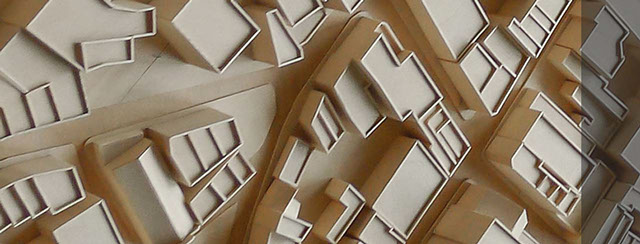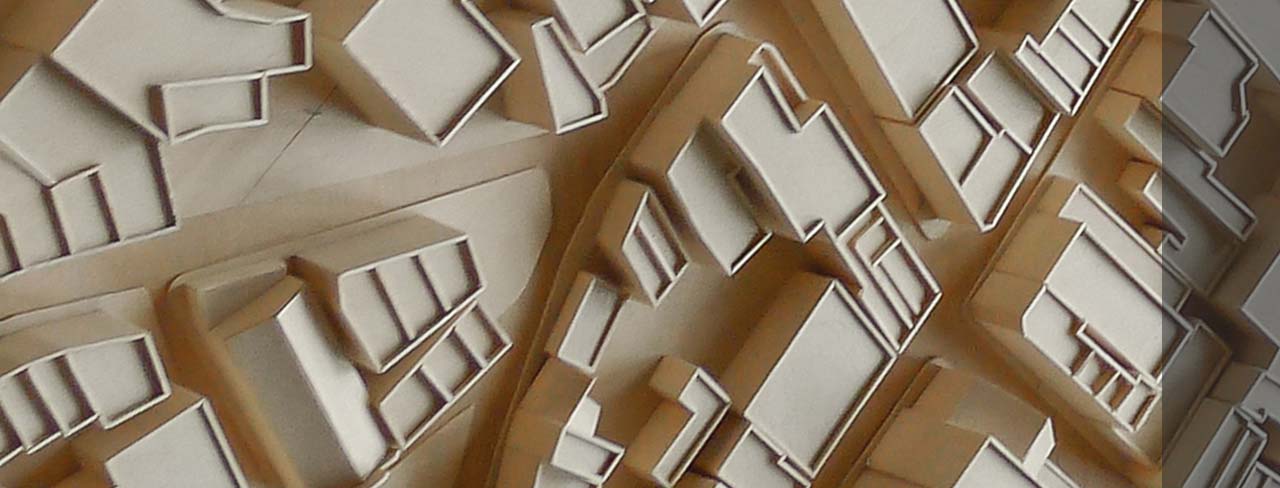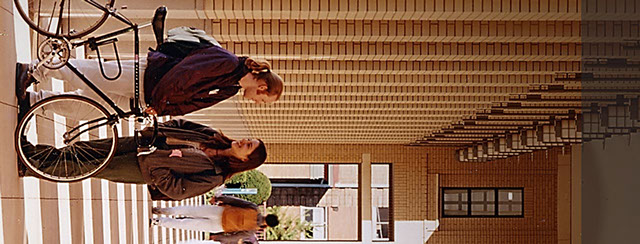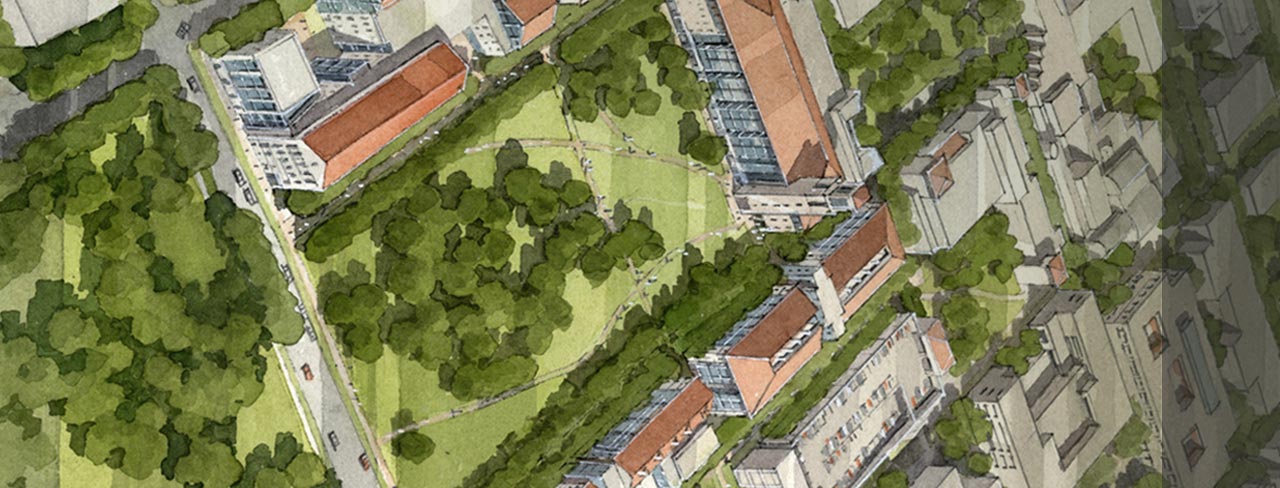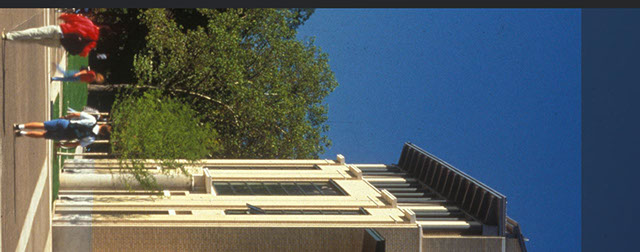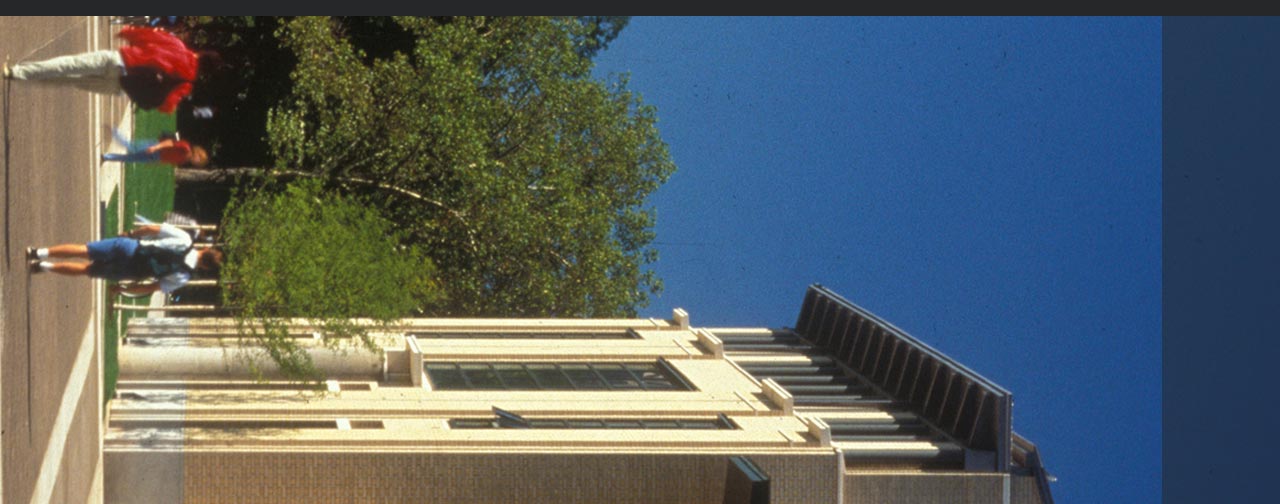










As a model of the city, the American campus may well be more suggestive
than the real thing; certainly it is one of America's truly original contributions
to urbanism."
Michael Dennis, Excursus Americanus
A…campus may achieve almost complete independence of buildings, but in so
doing it becomes more like a summer camp or a resort than an academic community.
To be a community requires density & proximity; it requires urbanity."
Michael Dennis, On Campus Design & Planning
…there can be cities without landscape, but landscape without density of
urban buildings and people cannot be a city."
Michael Dennis & Alistair McIntosh, Landscape and the City
Our whole culture is based on the idea of limitless resources and continuous growth,
and we have become so accustomed to the idea that we have forgotten that we live
on a finite planet."
Michael Dennis, Temples & Towns: Urban Principles for the 21st Century
The city requires both public and private accommodation, and it is architecture
that must mediate between the two related but not integrated realms."
Michael Dennis, Architecture & the Cumulative City
…it is not surprising to find most modern museums to be isolated, introverted, and
denuded versions of the ‘museum as a mechanism for storing and displaying art,'
with little regard for the public realm."
Michael Dennis, The Uffizi: Museum as Urban Design
Growing slowly, quietly maturing, modern architecture in America was like a
time bomb planted during the Enlightenment, armed during the 1920s, and set
to explode after World War II."
Michael Dennis, Excursus Americanus
…architects in our time have become very adept at servicing and delivering
complex programs, but they have also become less adept at designing—indeed,
even understanding—the public realm."
Michael Dennis, On Campus Design & Planning
Despite a continuously developing urban sensibility, however, architecture and
landscape have tended to pursue ever more autonomous, narcissistic, and anti-urban
directions, and this is inadequate to address twenty-first century issues."
Michael Dennis & Alistair McIntosh, Landscape and the City
What might be proposed instead is a hybrid architecture for a hybrid city, an
architecture of traditional rooms as well as “modern" space, of facades as well as
frames—an architecture that makes urban space as well as consumes it."
Michael Dennis, Architecture & the Cumulative City
But more than a century of destructive urban behavior has produced contemporary
architectural and urban conventions that are impotent to address twenty-first century
issues, much less for producing quality urban environments."
Michael Dennis, Temples & Towns: Urban Principles for the 21st Century
OUR PRACTICE
We are a full service general practice dedicated to the integration of architectural design, landscape design, and master planning. Our work comprehensively interrelates these disciplines to create a richer and more rewarding public realm, whether it be the streets and squares of a city, the quadrangles, paths, and playfields of a campus, or the communal spaces within an individual building.
Our senior staff has worked together for over 15 years, and together oversee the design and management of each project.
ABOUT OUR PRINCIPALS
SUSTAINABILITY& PLACEMAKING
Architectural design, landscape design, master planning, and urban design are all directed toward exploring and enhancing the unique qualities of place. These disciplines offer varied means to create rich social environments by defining and clarifying the public realm. Equally important, each of these disciplines also has a role to play in improving environmental sustainability by minimizing energy use and the consumption of natural resources.
URBAN DESIGN &CAMPUS PLANNING
The campus is, in some ways, a laboratory for the exploration and reconstruction of the urban condition. While campuses are often more diffusely built and more verdant than cities, the overarching principles hold true for both: using architecture and landscape to define space, clarify circulation, and link together and accommodate the needs of a disparate range of users, programs, activities, and meanings.
Our plans engage the often disjunctive and sprawling conditions of contemporary campuses and find ways to use increases in density (driven by facilities needs) to strengthen their spatial coherence, making them better places to live and work. In short, we use growth to define public space and create place—establishing a compelling yet flexible long range vision for the campus. Our primary means of accomplishing this is by defining a campus's civic structure—the spatial framework of interconnected campus streets, quadrangles, courtyards, parks, fields, and primary interior spaces that constitutes the campus's public realm and organizes its built fabric.
PLANNING PROJECTS
ARCHITECTURE
Good architectural design understands and responds to the unique physical conditions of site, program, and neighboring buildings and spaces, along with user needs, mission, and vision. It brings these disparate elements into accord, creating a physical response that satisfies both the tangible and intangible.
In all of our work, we seek an architecture that is inextricably knitted into its surroundings and that brings out the potential of its program—offering new relationships between users, program, site, district, landscape, interiors, and surrounding public spaces.
ARCHITECTURE PROJECTS
ACTIVE
PERIMETER
MEDIATING
ELEMENTS
COMMUNAL
SPACE
ARCHITECTURAL
CHARACTER
In a way, the design of a building is like the invention of a jigsaw puzzle piece—a missing piece shaped to resolve the demands of its surroundings. The building's form adapts, deforms, and adjusts to address and incorporate the axes, views, natural features, circulation routes, open spaces, and neighboring buildings that adjoin or affect the site. It brings the geometrical and perspectival aspects of its surroundings together, absorbing their influences and resolving them by positioning and shaping major interior spaces and programmatic elements so as to receive and engage them. In some cases this results in a conception of the building as a village of forms—its primary programmed spaces legible as identifiable volumes, and embedded in a matrix of circulation and service spaces.
CARNEGIE MELLON UNIVERSITY
CARNEGIE MELLON UNIVERSITY
CARNEGIE MELLON UNIVERSITY
CARNEGIE MELLON UNIVERSITY
PRINCETON UNIVERSITY
PRINCETON UNIVERSITY
PRINCETON UNIVERSITY
PRINCETON UNIVERSITY
Mediating elements—such as loggias, pergolas, gardens, and courtyards—are simultaneously part of a building and part of its surroundings. They dissolve the boundary between context and building by creating places that have aspects of both.
CARNEGIE MELLON
UNIVERSITY
UNIVERSITY OF TEXAS
PAN AMERICAN
UNIVERSITY OF
SOUTHERN CALIFORNIA
CORNELL UNIVERSITY
PRINCETON UNIVERSITY
CARNEGIE MELLON
UNIVERSITY
UNIVERSITY OF MIAMI
An interior public street or forum, whether part of a program or included beyond the stated programmatic requirements, celebrates the building's civic purpose as well as its users' sense of community. The primary interior public spaces within a building gather together its various passages and circulation routes, creating opportunities for spontaneous meetings and interactions.
CARNEGIE MELLON
UNIVERSITY
UNIVERSITY OF
MICHIGAN
EMORY UNIVERSITY
UNIVERSITY OF MIAMI
CARNEGIE MELLON
UNIVERSITY
CARNEGIE MELLON
UNIVERSITY
UNIVERSITY OF
ALABAMA
STUDENT CENTER
PROPOSAL
Sympathetic architectural character and use of compatible materials foster a sense of agreement and connection between buildings: a visual coherence ensuring that the whole of a district or neighborhood is greater than the sum of its individual buildings. The strong architectural traditions typical of college and university campuses make this especially relevant at academic institutions. We believe the architectural language of each building should adapt to the unique qualities of its institution—relating both to its physical and cultural context.
CARNEGIE MELLON
UNIVERSITY
CARNEGIE MELLON
UNIVERSITY
PRINCETON UNIVERSITY
PRINCETON UNIVERSITY
UNIVERSITY OF
SOUTHERN CALIFORNIA
UNIVERSITY OF
SOUTHERN CALIFORNIA
UNIVERSITY OF MIAMI
UNIVERSITY OF MIAMI
COLLABORATIVEDESIGN
We bring architectural inventiveness to each of our projects as well as a thorough understanding of a wide range of facility types, but this is nothing without collaborative engagement with our clients. Understanding all goals for a project—its social and institutional mission as well as its functional and spatial requirements—can only be achieved through an open, collaborative process.
We accomplish this by talking early and often, following up verbal ideas with physical design alternatives that test out concepts and interpretations. The process is cyclical and iterative, as preferred alternatives are continually developed and refined.
OUR HISTORY
Michael Dennis & Associates has been continuously engaged in practice in downtown Boston for 25 years as a sole proprietorship and for 6 years prior to that as the partnership Michael Dennis, Jeffrey Clark & Associates.
Michael's extensive and varied experience in teaching and research has a profound impact on how we approach both design and process.
FIRM HISTORY

MCCULLOUGH
STUDENT CENTER
Middlebury College

SHELTER FOR
ARCHAEOLOGICAL RUIN
American Excavations
at Morgantina

KENAN MUSIC
BUILDING
University of North Carolina at Chapel Hill

MUSIC BUILDING
PHASE II
University of North Carolina at Chapel Hill

UNIVERSITY CENTER
Carnegie Mellon University

EAST CAMPUS DORMITORY & DINING
Carnegie Mellon University

PARKING GARAGE
& STADIUM
Carnegie Mellon University

EMT BUILDING
FEASIBILITY STUDY
Carnegie Mellon University
ARCHITECTURE
PLANNING
CAMPUS MASTER PLAN
The University of Texas
Pan American
CAMPUS MASTER PLAN
The University of Texas
at El Paso
CAMPUS MASTER PLAN
Malaysia University of
Science & Technology
UNIVERSITY
CAMPUS PLAN
King Khalid University
UNIVERSITY PARK
CAMPUS MASTER PLAN
University of
Southern California
CAMPUS PLAN
PROPOSAL
Texas A&M University
Central Texas
WEST CAMPUS
RESIDENTIAL PLAN
Cornell University
HEALTH SCIENCE
CAMPUS MASTER PLAN
University of
Southern California
COMPREHENSIVE
FACILITIES PLAN
Belmont Technical
College
BROAD ST./ACADEMIC
CAMPUS PLAN
Virginia Commonwealth
University
COMMENTARY
ABOUT US
ABOUT US
CONTACT
ABOUT US
















